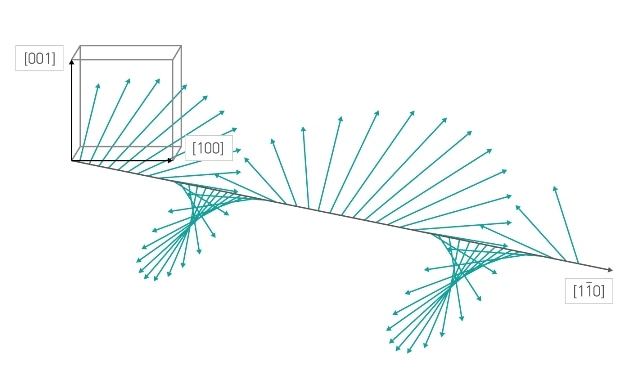May 24 2016
A group of researchers from the Moscow Institute of Physics and Technology (MIPT), the National Research University of Electronic Technology (MIET), and the Prokhorov General Physics Institute have suggested a hypothetical model that explains the unpredictably large values of the linear magnetoelectric effect in bismuth ferrite (BiFeO3) that have been analyzed in numerous experiments. The group also proposed a method to further improve the effect. The conclusions of this work have been published in the Physical Review B journal.
 The spin cycloid structure in BiFeO3. Source – MIPT press-office
The spin cycloid structure in BiFeO3. Source – MIPT press-office
One specific characteristic of BiFeO3 is that in vast samples, spins of Fe3+ iron ions are arranged like a cycloid. However, mechanical stress or a strong magnetic field can damage this spin structure. Devoid of a spin cycloid, BiFeO3 displays a huge linear magnetoelectric effect, which was the focus of the project.
The theoretical description presented in the paper may be applicable to other multiferroics similar to BiFeO3. This will help in predicting the value of their magnetoelectric effect, which, in turn, will make it easier to find new and promising materials for industrial applications.
Professor Anatoly Zvezdin, MIPT
Multiferroics and Magnetoelectric Effect
Multiferroics are a class of materials that concurrently show various ferroic orders, such as ferroelectric, magnetic, and/or ferroelastic. A magnetoelectric (ME) effect may take place if there is an interaction among magnetic and electric subsystems in a material.
The magnetoelectric effect occurs when electric polarization and magnetization take place under the effect of an external magnetic field and an electric field, respectively. This permits an electric field to be utilized to manage a material’s magnetic properties and a magnetic field to be utilized to manage the electric properties. If the ME effect’s value is large (dozens or hundreds of times greater than normal), it is referred to as a giant ME effect.
The major application of the ME effect is in static and variable magnetic field sensors. These sensors have profound application in electric motors, navigation systems, and as well as in vehicle ignition systems. In comparison to analogous devices based on magnetoresistance or the Hall effect, ME effect-based sensors are not only more sensitive (in accordance with study, up to a million times more sensitive), but also comparatively economical to manufacture.
In addition, the ME effect provides interesting potentials for the utilization of multiferroics in new kinds of magnetic memory, such as ROM – read only memory. It can also be potentially used to develop highly accurate equipment to work with radiation in the microwave range, and to transmit power wirelessly to small electronic devices.
Bismuth Ferrite
The topic of the project was BiFeO3, which is a highly capable multiferroic that holds great potential based on its practical applications. It is proposed to be used for producing ultra energy-efficient magnetoelectric memory.
At room temperature, BiFeO3 also shows a magnetoelectric effect, whilst in majority of the magnetoelectrics an ME effect of this extent is seen at very low temperatures (less than -160°C) only. BiFeO3 is an antiferromagnetic, meaning that the magnetic moments of its magnetic sublattices (structures created by atoms having the same parallel spins) cancel out each other, and the material’s overall magnetization is almost zero. Conversely, the same cycloidal spin structure is formed by the spins’ spatial arrangement.
It was considered in the 1980s that this multiferroic showed a quadratic magnetoelectric effect only which means polarization is quadratically proportional to the magnetic field applied. The reality that the linear magnetoelectric effect “went unnoticed” for very long was linked with the spin cycloid, because of the spin cycloid structure, few features like magnetization and the magnetoelectric effect “average out” to zero. Nevertheless, BiFeO3 is positioned in a strong magnetic field (higher than a specific critical value), the structure gets damaged and this was followed by the appearance of a linear ME effect (when polarization is linearly proportional to the field applied).
Initial experiments showed a small value of the linear magnetoelectric effect in BiFeO3 (nearly 1000 times less than the actual value), but afterward experimental studies showed a huge ME effect and it was also confirmed by utilizing it in layered structures, record values of the magnetoelectric effect could be achieved.
The paper’s authors created a hypothetical explanation for the incidence of the linear ME effect on the basis of Ginzburg-Landau theory and elaborated the large experimental value of the earlier effect reported earlier. As part of their hypothesis, the scientists also demonstrated that the ME effect can be considerably improved in the presence of an electrostatic field.